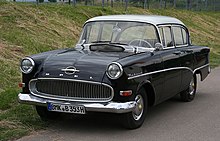Two-tone paint



A two-tone paint was an option for many since the 1950s auto suppliers .
However, the technical production effort for a second car color is not small. A car first had to be painted in its basic color, then after the paint had hardened the vehicle had to be masked off, the paint in the areas of the second paint had to be sanded again, then the second paint had to be applied.
In the beginning, the intersection between the two colors was often the so-called belt line at about two thirds of the flank height of the doors and fenders. The border was placed in an area that was mostly covered by the moldings.
Later, instead of the entire upper half of the vehicle, it was preferred to only use a second color for the roof and its pillars. But this procedure was still quite time-consuming. Therefore the surcharges for the second color on the car were always considerable, because two drying phases and the intermediate processing with masking and sanding are expensive.
It is significant that after the end of the two-color era around 1970, such an option was almost no longer offered. Two-tone paintwork simply would not fit into today's tight, sophisticated production processes in automotive engineering. Nowadays it is the ultimate luxury because it can only be manufactured individually. Only a few models, such as the Maybach 57 and 62 or the Bugatti Veyron 16.4 , but also the Lancia Delta are still offered in two-tone paintwork.
The Lancia Thesis from 2005 to 2009 and the Lancia Ypsilon were also available in two-tone paintwork upon customer request . The buyer could specify two colors himself, which was then delivered as a bicolor version.
The two-tone paintwork was followed for a while in the early 1970s by the vinyl roof as a visual design option.
For a short time there was an interesting attempt at multi-color painting in the VW Group: the "Harlequin" models of the VW Polo . The Harlequin Polo was supposed to provide evidence of a more complex, high-quality body construction (precise joints and gaps) by dismantling painted complete bodies with doors and hoods, and reassembling the components in a different, "colorful sequence". The proof of quality was that the joints and gaps on the hoods and doors of different pre-manufactured vehicles could still be adjusted evenly, which only works if a high level of accuracy is mastered in the body construction of the pressed parts and in the assembly despite large sheet metal surfaces.
